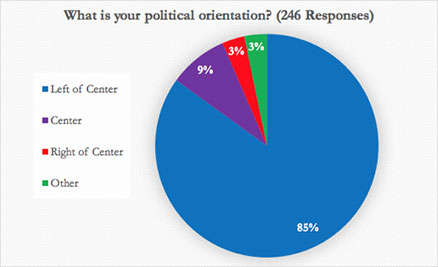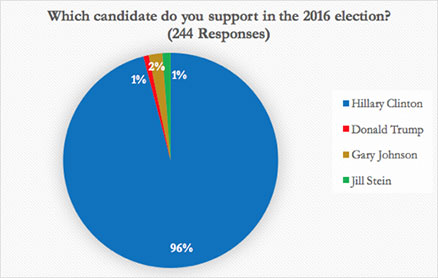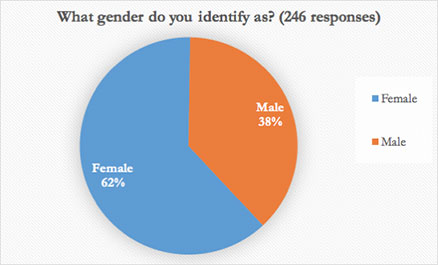Millennial Caucus’s straw poll

In a recent undergraduate survey at the University of Virginia, the overwhelming majority of respondents support Secretary Hillary Clinton for president, not a surprise given national trends among young voters. What is notable is the margin of her victory. Also, third-party candidates Gary Johnson and Jill Stein outpolled Republican nominee Donald Trump. These results came as part of the Fall 2016 iteration of the Millennial Caucus, a student-led poll conducted in conjunction with the Miller Center.
Secretary Clinton is the unequivocal first choice, netting 234 votes from the aggregate 246 participants in the survey. The vast majority of respondents identify with the political left. Thus, her victory was to be expected. However, the percentage of individuals supporting Clinton is higher than the combined totals of those who identify as left of center (85%) and center (8.5%). This suggests that Clinton’s support pulls from conservative areas of the political spectrum, indicating a broader range of support across Grounds than anticipated.

The size of Clinton’s lead among students contrasts sharply with the most recent national polls aggregated by RealClearPolitics. These show Clinton up six points at 45.2% to Trump’s 39.2%. This is consistent with statewide data, which shows her up five points with 48% to Trump’s 43%.
National surveys of young voters (18-29) show a more direct contrast. A USA Today poll indicates that Secretary Clinton’s lead among millennials is currently at 48% in a 4-way ballot, with 68% of millennial voters supporting Clinton compared to 20% for Trump. While this is wider than general population figures, it is still a much smaller gap than what we see on Grounds.

There are a few potential reasons for this disparity. One, college-educated millennials tend to exhibit higher rates of support for Clinton. Two, those polled who live or even attend college in more rural areas are also more likely to support Trump than undergraduates at the University of Virginia. Three, the sample surveyed skewed heavily left. Finally, the majority of participants were female, a favorable demographic for Clinton. A poll conducted by The Atlantic found that Clinton’s lead among millennials is mimicked by her support among female voters who chose the Democratic nominee 61% of the time while opting for Mr. Trump just 28% of the time.
Furthermore, in the Millennial Caucus poll, both third-party candidates outpolled the Republican nominee, with Gary Johnson polling at 2% and Jill Stein polling at 1.2% compared to Trump’s 0.8%. Johnson and Stein are currently netting 6.4% and 2.5% respectively in the national polls. Given the small sample size, the difference between national polling data for these third party candidates and what we saw here is not notable. The more surprising fact is that their low totals are enough to outpace Trump, who fell nearly 40 points from his national average.
There are two primary takeaways from the Millennial Caucus poll: UVA students surveyed prefer Secretary Clinton by an overwhelming margin, with support extending beyond those leaning left or center left. Simultaneously, Donald Trump proved highly unpopular, finishing a distant fourth in what is a two-way race nationally.
The Millennial Caucus is a student-led initiative that promotes the views of undergraduate students from the University of Virginia on the topics covered by the Miller Center’s First Year 2017 project. This survey was conducted in October 2016, reached the inboxes of 3624 students, and had a + 5 margin of error. For more about this project, click here.